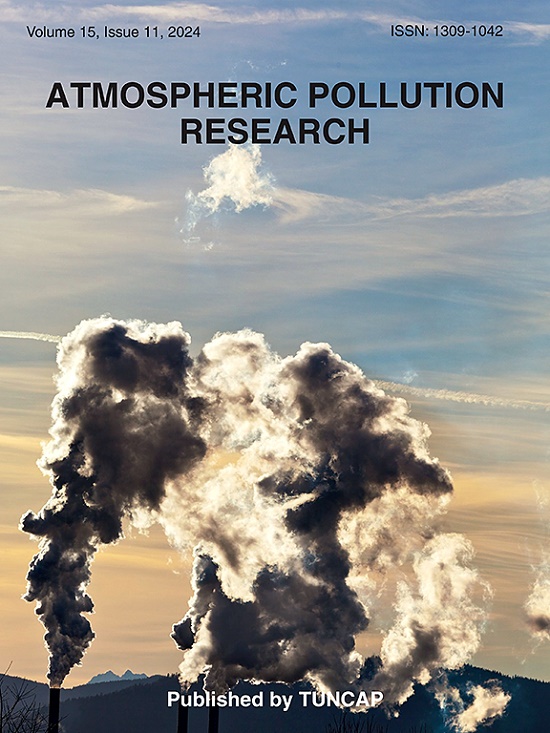Widening cost-benefits gap of emission control measures in India from 2017 to 2022
IF 3.5
3区 环境科学与生态学
Q2 ENVIRONMENTAL SCIENCES
引用次数: 0
Abstract
The Indian government has implemented stricter emission reduction policies to alleviate pollution in recent years, though their impact on air quality remains uncertain. This study uses the Community Multiscale Air Quality (CMAQ) model to simulate PM2.5 and O3 concentrations in India from 2017 to 2022, assessing the response of pollutant emissions and evaluating effects on air quality and public health. We assess the total costs of emission reduction policies and potential lives saved through improved air quality, providing a preliminary estimate of policy effectiveness. While emissions of SO2, PM2.5, PM10, and black carbon declined, emissions of NH3, VOC, and organic carbon increased, with CO and NOx remaining stable. The total cost of emission reductions increased from $31.9 billion in 2017 to $47.4 billion in 2022, with NOx reductions accounting for over 70 % of the total. Despite these efforts, PM2.5 and maximum daily 8-h average (MDA8) O3 concentrations generally rose in most years, showing a synchronized pattern. This contributed to an increase in premature deaths, from 2.1 million to 2.4 million, with cardiovascular diseases due to PM2.5 exposure accounting for over 40 % of these deaths. The increasing costs of emission reductions, excluding a brief decline in 2020, led to negative health benefits and a widening cost-benefit gap. By 2022, net benefits were recorded at -$126.7 billion, marking a 14 % decrease from 2018. These findings highlight the need for future policies to improve cost-effectiveness and maximize health benefits for sustainable air quality improvements.
2017 - 2022年印度排放控制措施成本效益差距扩大
近年来,印度政府实施了更严格的减排政策来缓解污染,尽管这些政策对空气质量的影响仍不确定。本研究使用社区多尺度空气质量(CMAQ)模型模拟2017年至2022年印度PM2.5和O3浓度,评估污染物排放的响应,并评估对空气质量和公众健康的影响。我们评估了减排政策的总成本和通过改善空气质量挽救的潜在生命,提供了对政策有效性的初步估计。SO2、PM2.5、PM10和黑碳排放量下降,NH3、VOC和有机碳排放量增加,CO和NOx保持稳定。减排总成本从2017年的319亿美元增加到2022年的474亿美元,其中氮氧化物减排占总成本的70%以上。尽管如此,PM2.5和最大日8小时平均值(MDA8) O3浓度在大多数年份总体呈上升趋势,且呈同步上升趋势。这导致过早死亡人数从210万增加到240万,其中PM2.5暴露导致的心血管疾病占这些死亡人数的40%以上。减少排放的成本不断增加,不包括2020年的短暂下降,导致了负面的健康效益和不断扩大的成本效益差距。到2022年,净收益为1267亿美元,比2018年下降14%。这些发现突出表明,未来需要制定政策,以提高成本效益,并最大限度地提高可持续空气质量改善的健康效益。
本文章由计算机程序翻译,如有差异,请以英文原文为准。
求助全文
约1分钟内获得全文
求助全文
来源期刊

Atmospheric Pollution Research
ENVIRONMENTAL SCIENCES-
CiteScore
8.30
自引率
6.70%
发文量
256
审稿时长
36 days
期刊介绍:
Atmospheric Pollution Research (APR) is an international journal designed for the publication of articles on air pollution. Papers should present novel experimental results, theory and modeling of air pollution on local, regional, or global scales. Areas covered are research on inorganic, organic, and persistent organic air pollutants, air quality monitoring, air quality management, atmospheric dispersion and transport, air-surface (soil, water, and vegetation) exchange of pollutants, dry and wet deposition, indoor air quality, exposure assessment, health effects, satellite measurements, natural emissions, atmospheric chemistry, greenhouse gases, and effects on climate change.
 求助内容:
求助内容: 应助结果提醒方式:
应助结果提醒方式:


